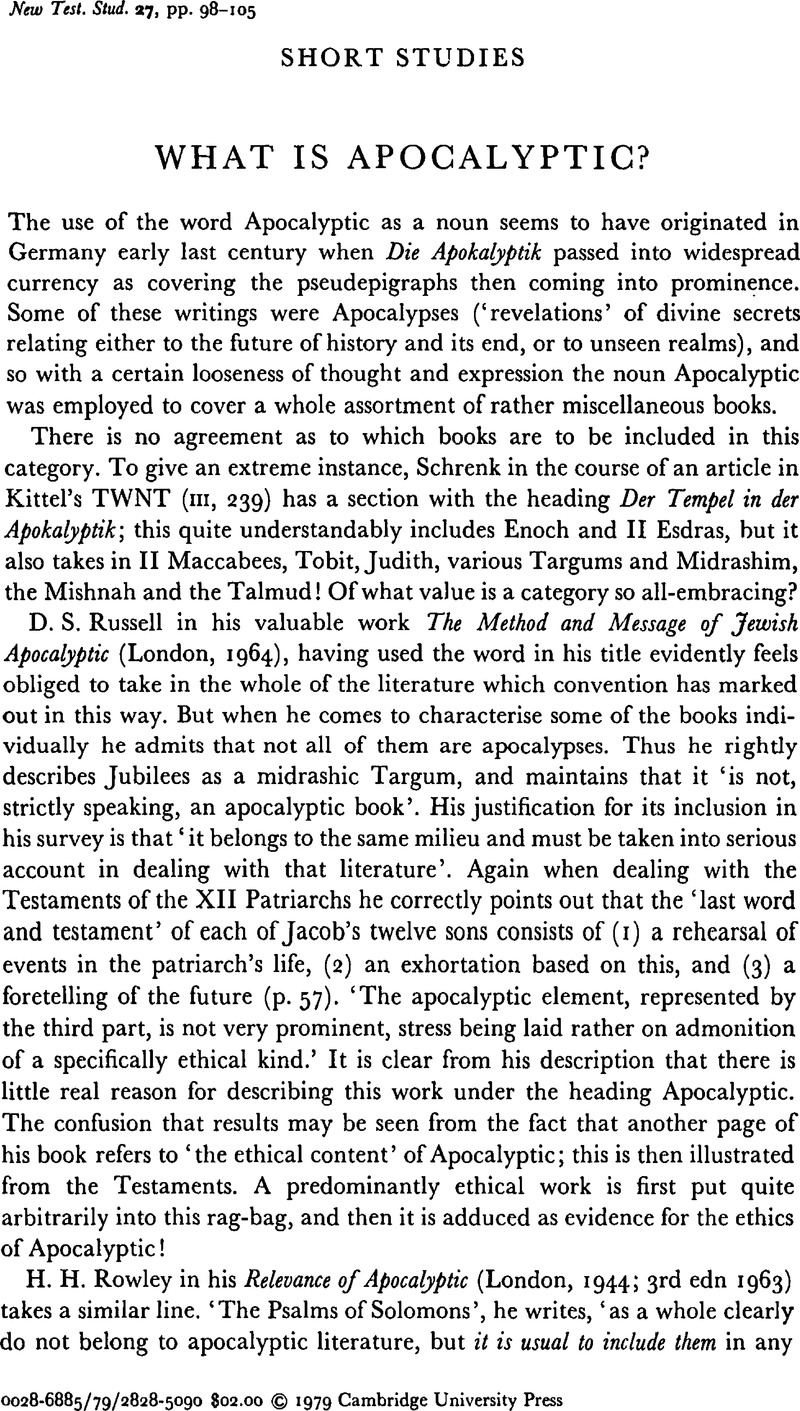Article contents
What is Apocalyptic?
Published online by Cambridge University Press: 05 February 2009
Abstract

- Type
- Short Studies
- Information
- Copyright
- Copyright © Cambridge University Press 1980
References
1 (London, 1967; Eng. trans. of Heil als Geschichte, Tübingen, 1965).Google Scholar
2 (London, 1972; Eng. trans. of Ratlos vor der Apokalyptik, Gütersloh, 1970.)Google Scholar
3 E.g. Bultmann, R., N.T.S. 1 (1954–1955), 6 f.Google Scholar
4 I would at this point re-echo the title of an important article by Leivestad, R., ‘Exit the Apocalyptic Son of Man’ (N.T.S. 18, 1971–1972, 243–67)Google Scholar. One cannot feel that Lindars, B. provides an adequate reply or justifies the title of his response, ‘Re-enter the Apocalyptic Son of Man’ (N.T.S. 22, 1975–1976, 52–72Google Scholar). What Lindars attempts is the establishment of a new apocalyptic myth (cf. his Manson, Lecture, ‘The Apocalyptic Myth and the Death of Christ’, Manchester, 1975)Google Scholar. He argues that ‘apocalyptic thought embraces the concept of an agent of God in the coming judgement who may be a character of the past reserved in heaven for this function at the end time’ N.T.S. XXII, 54). He instances, among other references, Melchizedek as presented in the Qumran fragment (II Q Melchizedek), Enoch, and (in the Manson Lecture) Abel as he appears in the Testament of Abraham.
Let us look at the last mentioned. The date of this work is uncertain; M. R. James regarded it as a Christian work of the second century. Others think it is Jewish and comes from the former half of the first century A.D. But whatever its provenance it should be noticed that Abel does not conduct the last judgement but one that is continuing in the present; apparently he judges souls immediately after death to decide their intermediate fate (see chs. XII-XIII). The final judgement in this writing is explicitly ascribed to God. Can it be claimed that this figure of Abel helps to rehabilitate the apocalyptic Son of Man? Abel is not a Messianic figure; he does not descend in glory, nor does he have any function in the last judgement attributed to him.
The work of Melchizedek in the Qumran fragment is quite different; he assists not at a forensic judgement but at the military conquest of God's enemies during the eschatological war ( see the text in N.T.S. II, 1965–1966, 302 f.). The case of Enoch in the Similitudes is different again.
Moreover these figures all belonged to the remote past, two of them being antediluvian. It is difficult to see the justification for linking such disparate figures together, making a composite construction described as ‘the apocalyptic myth’, and then proceeding to claim that an idea of this kind was a potent force in New Testament christology.
5 Rightly pointed out by Ladd, G. E. in his excellent book Jesus and the Kingdom (London 1966, pp. 126 f.)Google Scholar.
6 The words of G. F. Moore are worth recalling in this connection. He is referring to Die Religion des Judentums: ‘Bousset uses as his primary sources almost exclusively the writings commonly called Apocrypha and Pseudepigrapha, with an especial penchant for the apocalypses; and only secondarily, and almost casually, the writings which represent the acknowledged and authoritative teaching of the school, and the more popular instruction of the synagogue’ (Harvard Theological Review, XIV (1921), 243). On the subject of the Kingdom cf. my contribution to Texte und Undersuchungen, LXXXVIII (1964), 190–203, ‘The Kingdom as cosmic catastrophe’, and my article in J.T.S. XXVIII (1977), 289–302, ‘Schweitzer's influence – blessing or bane?’. See also a forthcoming work by Jean Carmignac, Le mirage de ľeschatologie.
7 Kingdom of God and Son of Man London, 1938, p. 175Google Scholar; Eng. trans. of Reich Gottes und Menschenssohn, München, 1934)Google Scholar. Otto includes Slavonic Enoch (II Enoch) in the tradition of ‘Enoch's apocalyptic’ which Jesus clearly followed. It may be said concerning this work that it is almost certainly several centuries later than the time of Jesus. Kirsopp Lake wrote that it could not be earlier than the seventh century; and after referring to the arguments of Mrs Maunder and J. K. Fotheringham added, ‘I can see no loophole of escape from this contention. It is as convincing evidence as has ever been produced for the dating of a document of uncertain origin’ (H.T.R. XVI, 397 f.). Howard, W. F. in Romance of NT Scholarship (London, 1949Google Scholar) wrote that the late date of II Enoch ‘is now generally seen to be beyond question’ (p. 109).
As for Ethiopic Enoch (I Enoch) I have shown in my book The Second Advent that R. H. Charles's list of parallels between Enoch and the Gospels dissolves almost entirely away when subjected to close scrutiny (cf. ch. 4, ‘Enoch and the New Testament’). The doubts I expressed about the very existence of the similitudes (En. 37–71) in the time of Jesus have been greatly strengthened by the evidence of the Qumran Scrolls. Almost every other chapter is represented by the fragments of Enoch but not a syllable of 37–71 has come to light; for detailed evidence see ‘Problèmes de la littérature Hénochique à la lumière des fragments Araméens de Qumran’ (H.T.R. LXIV, 1971, 333–78).Google Scholar
8 The Promise of His Coming, p. 154; quoted in Robinson's, J. A. T.Jesus and His Coming (London, 1957), p. 97Google Scholar. Robinson himself takes the position that ‘Jesus had far more in common with the Prophets than with the Apocalyptic writers’.
- 3
- Cited by


